Acoustic Metamaterial Design by Phase Delay Derivation Using Transfer Matrix
Abstract
1. Introduction
2. Theory
2.1. Acoustic Metasurface Design
2.1.1. Generalized Snell’s Law
2.1.2. Phase Delay Derivation Using a Transfer Matrix
2.2. Phase Delay Derivation Method
2.2.1. Method for Deriving Phase Delay in Case of a Quarter-Wave Resonator
2.2.2. Method for Deriving Phase Delay Using a Transfer Matrix
2.3. Description of the Speaker Test Setup
3. Results and Discussion
3.1. Comparison of Theoretical and FEM Methods for the Quarter-Wave Resonator
3.2. Silencer Design with Quarter-Wave Resonator Metasurface
3.3. Acoustic Analysis of a Silencer with a Quarter-Wave Resonator Metasurface
3.4. Speaker Test of a Silencer with a Quarter-Wave Resonator Metasurface
3.5. Silencer Design with the Labyrinthine-Type Resonator Metasurface
3.6. Acoustic Analysis and Speaker Test of the Silencer with the Labyrinthine-Type Resonator Metasurface
4. Conclusions
- In order to design a metasurface with a complex structure, a method for accurately deriving the phase delay is presented. This method uses the pressure and velocity derived from the FEM and the transfer matrix of the main duct. Using the proposed method, a metasurface with acoustic elements arranged symmetrically was designed.
- The phase delay of the quarter-wave resonator metasurface, which can be derived mathematically, was derived by the method presented in this study. Through comparison of the phase delay graph derived by the proposed method and the mathematical method, it was confirmed that they matched. Through this, it was found that the method presented in this study is accurate.
- To design a metasurface with a labyrinthine-type resonator, the method proposed in this study was used. The effect of the silencer composed of this metasurface was confirmed through acoustic analysis. In addition, the noise reduction effect was confirmed through a speaker test.
Author Contributions
Funding
Institutional Review Board Statement
Informed Consent Statement
Data Availability Statement
Conflicts of Interest
Appendix A. The Acoustic-Element Transfer Matrix
Appendix B. The Acoustic Pressure Transmission Ratio
References
- Wang, Z.H.; Hui, C.K.; Ng, C.F. The Acoustic Performance of Ventilated Window with Quarter-Wave Resonators and Membrane Absorber. Appl. Acoust. 2014, 78, 1–6. [Google Scholar] [CrossRef]
- Field, C.D.; Fricke, F.R. Theory and Applications of Quarter-Wave Resonators: A Prelude to Their Use for Attenuating Noise Entering Buildings through Ventilation Openings. Appl. Acoust. 1998, 53, 117–132. [Google Scholar] [CrossRef]
- Xu, M.B.; Selamet, A.; Kim, H. Dual Helmholtz Resonator. Appl. Acoust. 2010, 71, 822–829. [Google Scholar] [CrossRef]
- Selamet, A.; Kim, H.; Huff, N.T. Leakage Effect in Helmholtz Resonators. J. Acoust. Soc. Am. 2009, 126, 1142–1150. [Google Scholar] [CrossRef] [PubMed]
- Selamet, E.; Selamet, A.; Iqbal, A.; Kim, H. Acoustics of a Helmholtz Resonator Aligned Parallel with Flow: A Computational Study VS. Experiments. Int. J. Mater. Mech. Manuf. 2013, 1, 210–213. [Google Scholar] [CrossRef][Green Version]
- Selamet, A.; Radavich, P.M.; Dickey, N.S.; Novak, J.M. Circular Concentric Helmholtz Resonators. J. Acoust. Soc. Am. 1997, 101, 41–51. [Google Scholar] [CrossRef]
- Selamet, A.; Lee, I. Helmholtz Resonator with Extended Neck. J. Acoust. Soc. Am. 2003, 113, 1975–1985. [Google Scholar] [CrossRef]
- Kim, H.; Selamet, A. Acoustic Performance of a Helmholtz Resonator with Flow. Int. J. Veh. Noise Vib. 2011, 7, 285. [Google Scholar] [CrossRef]
- Selamet, E.; Selamet, A.; Iqbal, A.; Kim, H. Effect of Flow on Helmholtz Resonator Acoustics: A Three-Dimensional Computational Study vs. Experiments. SAE Tech. Pap. 2011. [Google Scholar] [CrossRef]
- Cai, C.; Mak, C.M.; Wang, X. Noise Attenuation Performance Improvement by Adding Helmholtz Resonators on the Periodic Ducted Helmholtz Resonator System. Appl. Acoust. 2017, 122, 8–15. [Google Scholar] [CrossRef]
- Griffin, S.; Lane, S.A.; Huybrechts, S. Coupled Helmholtz Resonators for Acoustic Attenuation. J. Vib. Acoust. Trans. ASME 2001, 123, 11–17. [Google Scholar] [CrossRef]
- Kim, H.; Selamet, A. Effect of Flow on a Dual Helmholtz Resonator. J. Mech. Sci. Technol. 2020, 34, 581–588. [Google Scholar] [CrossRef]
- Kwon, Y.; Kim, H. High-Speed Fan Noise Reduction Device Using a Continuous Helmholtz Resonator. Trans. Korean Soc. Mech. Eng. A 2022, 46, 363–369. [Google Scholar] [CrossRef]
- Kim, H.; Lee, I. Effect of Flow on Various Helmholtz Resonators. Int. J. Acoust. Vib. 2020, 25, 73–78. [Google Scholar] [CrossRef]
- Kim, H.; Kang, S.-K.; Lim, Y.-S. Muffler Design Using Transmission Loss Prediction Considering Heat and Flow. Trans. Korean Soc. Noise Vib. Eng. 2014, 24, 600–605. [Google Scholar] [CrossRef][Green Version]
- Selamet, A.; Xu, M.B.; Lee, I.-J.; Huff, N.T. Helmholtz Resonator Lined with Absorbing Material. J. Acoust. Soc. Am. 2005, 117, 725–733. [Google Scholar] [CrossRef]
- Liu, Z.; Zhang, X.; Mao, Y.; Zhu, Y.Y.; Yang, Z.; Chan, C.T.; Sheng, P. Locally Resonant Sonic Materials. Science 2000, 289, 1734–1736. [Google Scholar] [CrossRef]
- Fang, N.; Xi, D.; Xu, J.; Ambati, M.; Srituravanich, W.; Sun, C.; Zhang, X. Ultrasonic Metamaterials with Negative Modulus. Nat. Mater. 2006, 5, 452–456. [Google Scholar] [CrossRef]
- Lee, S.H.; Park, C.M.; Seo, Y.M.; Wang, Z.G.; Kim, C.K. Composite Acoustic Medium with Simultaneously Negative Density and Modulus. Phys. Rev. Lett. 2010, 104, 054301. [Google Scholar] [CrossRef]
- Zhu, Y.F.; Zou, X.Y.; Liang, B.; Cheng, J.C. Acoustic One-Way Open Tunnel by Using Metasurface. Appl. Phys. Lett. 2015, 107, 113501. [Google Scholar] [CrossRef]
- Liu, G.S.; Zhou, Y.; Liu, M.H.; Yuan, Y.; Zou, X.Y.; Cheng, J.C. Acoustic Waveguide with Virtual Soft Boundary Based on Metamaterials. Sci. Rep. 2020, 10, 981. [Google Scholar] [CrossRef] [PubMed]
- Yamamoto, T. Acoustic Metamaterial Plate Embedded with Helmholtz Resonators for Extraordinary Sound Transmission Loss. J. Appl. Phys. 2018, 123, 215110. [Google Scholar] [CrossRef]
- Qi, S.; Assouar, B. Ultrathin Acoustic Metasurfaces for Reflective Wave Focusing. J. Appl. Phys. 2018, 123, 234501. [Google Scholar] [CrossRef]
- Wang, W.; Xie, Y.; Konneker, A.; Popa, B.I.; Cummer, S.A. Design and Demonstration of Broadband Thin Planar Diffractive Acoustic Lenses. Appl. Phys. Lett. 2014, 105, 2012–2015. [Google Scholar] [CrossRef]
- Liang, Z.; Feng, T.; Lok, S.; Liu, F.; Ng, K.B.; Chan, C.H.; Wang, J.; Han, S.; Lee, S.; Li, J. Space-Coiling Metamaterials with Double Negativity and Conical Dispersion. Sci. Rep. 2013, 3, 1614. [Google Scholar] [CrossRef]
- Ge, Y.; Sun, H.X.; Yuan, S.Q.; Lai, Y. Broadband Unidirectional and Omnidirectional Bidirectional Acoustic Insulation through an Open Window Structure with a Metasurface of Ultrathin Hooklike Meta-Atoms. Appl. Phys. Lett. 2018, 112, 243502. [Google Scholar] [CrossRef]
- Ge, Y.; Sun, H.X.; Yuan, S.Q.; Lai, Y. Switchable Omnidirectional Acoustic Insulation through Open Window Structures with Ultrathin Metasurfaces. Phys. Rev. Mater. 2019, 3, 065203. [Google Scholar] [CrossRef]
- Han, D.Y.; Peng, Y.Y.; Liu, G.S.; Zou, X.Y.; Cheng, J.C. Tunable Pipe-Type Acoustic Metamaterials Based on Piezoelectric Composite Side-Branches. J. Appl. Phys. 2021, 129, 084505. [Google Scholar] [CrossRef]
- Zhang, H.L.; Zhu, Y.F.; Liang, B.; Yang, J.; Yang, J.; Cheng, J.C. Sound Insulation in a Hollow Pipe with Subwavelength Thickness. Sci. Rep. 2017, 7, 44106. [Google Scholar] [CrossRef]
- Ghaffarivardavagh, R.; Nikolajczyk, J.; Glynn Holt, R.; Anderson, S.; Zhang, X. Horn-like Space-Coiling Metamaterials toward Simultaneous Phase and Amplitude Modulation. Nat. Commun. 2018, 9, 1349. [Google Scholar] [CrossRef]
- Seybert, A.F.; Ross, D.F. Experimental Determination of Acoustic Properties Using a Two-Microphone Random-Excitation Technique. J. Acoust. Soc. Am. 1977, 61, 1362–1370. [Google Scholar] [CrossRef]
- Chung, J.Y.; Blaser, D.A. Transfer Function Method of Measuring In-Duct Acoustic Properties. I. Theory. J. Acoust. Soc. Am. 1980, 68, 907–913. [Google Scholar] [CrossRef]
- Chung, J.Y.; Blaser, A. Transfer Function Method of Measuring In-Duct Acoustic Properties. II. Experiment. J. Acoust. Soc. Am. 1980, 68, 914–921. [Google Scholar] [CrossRef]
- Singh, R.; Katra, T. Development of an Impulse Technique for Measurement of Muffler Characteristics. J. Sound Vib. 1978, 56, 279–298. [Google Scholar] [CrossRef]
- To, C.W.S.; Doige, A.G. A Transient Testing Technique for the Determination of Matrix Parameters of Acoustic Systems, I: Theory and Principles. J. Sound Vib. 1979, 62, 207–222. [Google Scholar] [CrossRef]
- To, C.W.S.; Doige, A.G. A Transient Testing Technique for the Determination of Matrix Parameters of Acoustic Systems, II: Experimental Procedures and Results. J. Sound Vib. 1979, 62, 223–233. [Google Scholar] [CrossRef]
- Lung, T.Y.; Doige, A.G. A Time-averaging Transient Testing Method for Acoustic Properties of Piping Systems and Mufflers with Flow. J. Acoust. Soc. Am. 1983, 73, 867–876. [Google Scholar] [CrossRef]
- Munjal, M.L. Acoustics of Ducts and Mufflers; Wiley: Hoboken, NJ, USA, 2014. [Google Scholar]
- He, S. A Transfer Matrix Approach to Determine the Low Frequency Insertion Loss of Enclosures Including Applications. Master’s Thesis, University of Kentucky, Lexington, KY, USA, 2017. [Google Scholar]
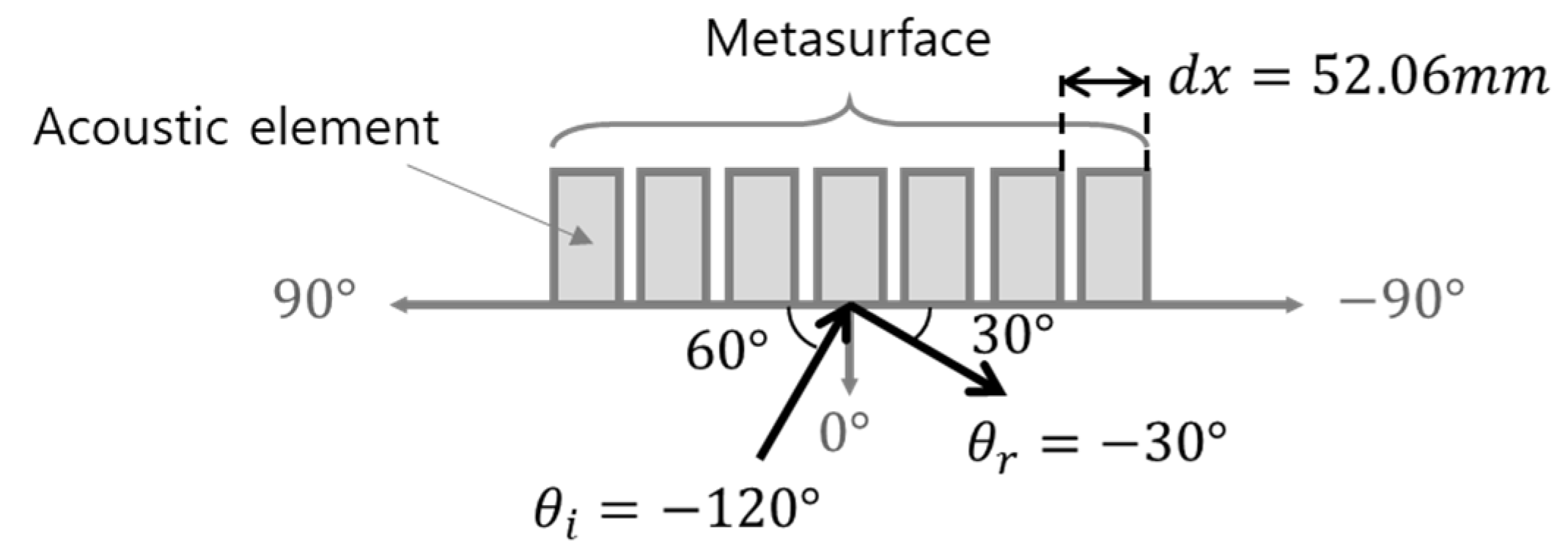
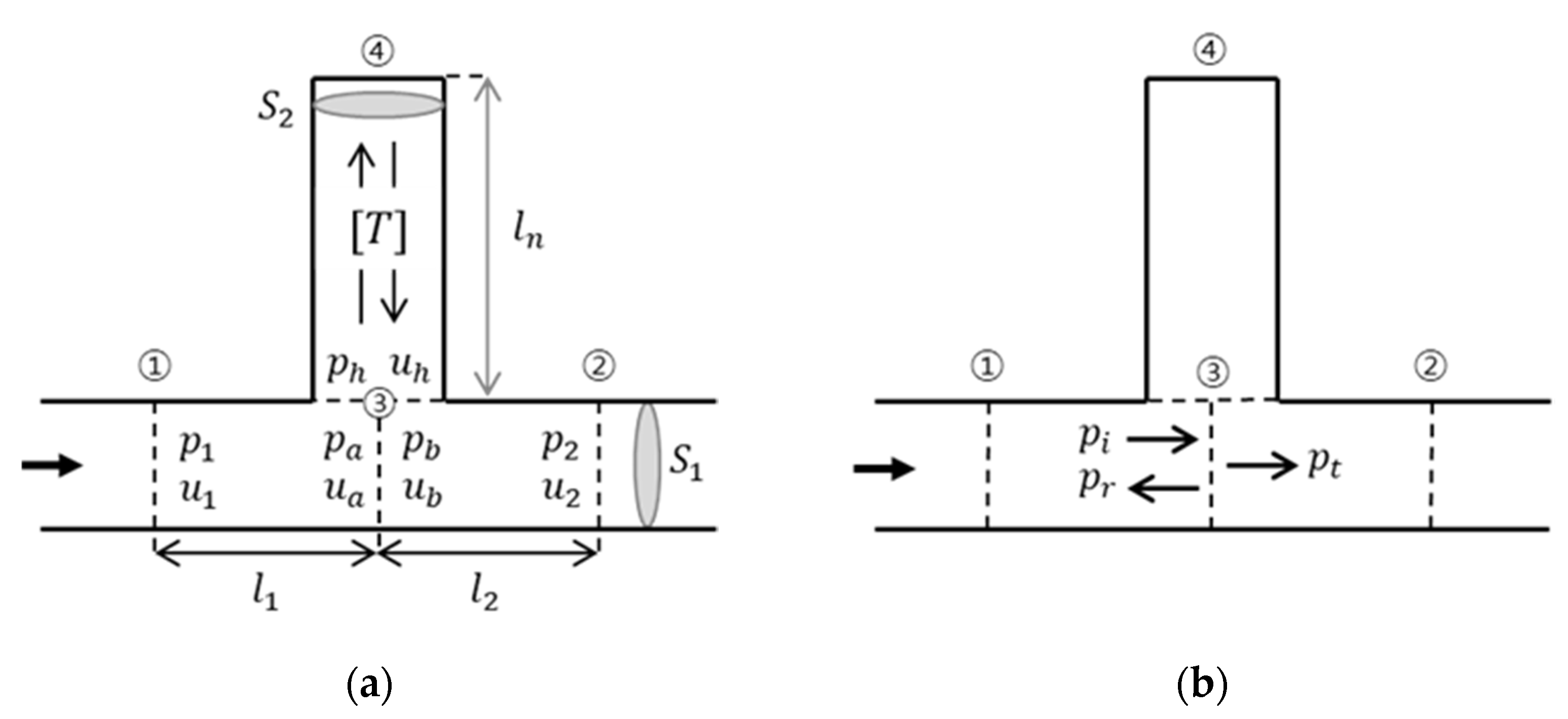
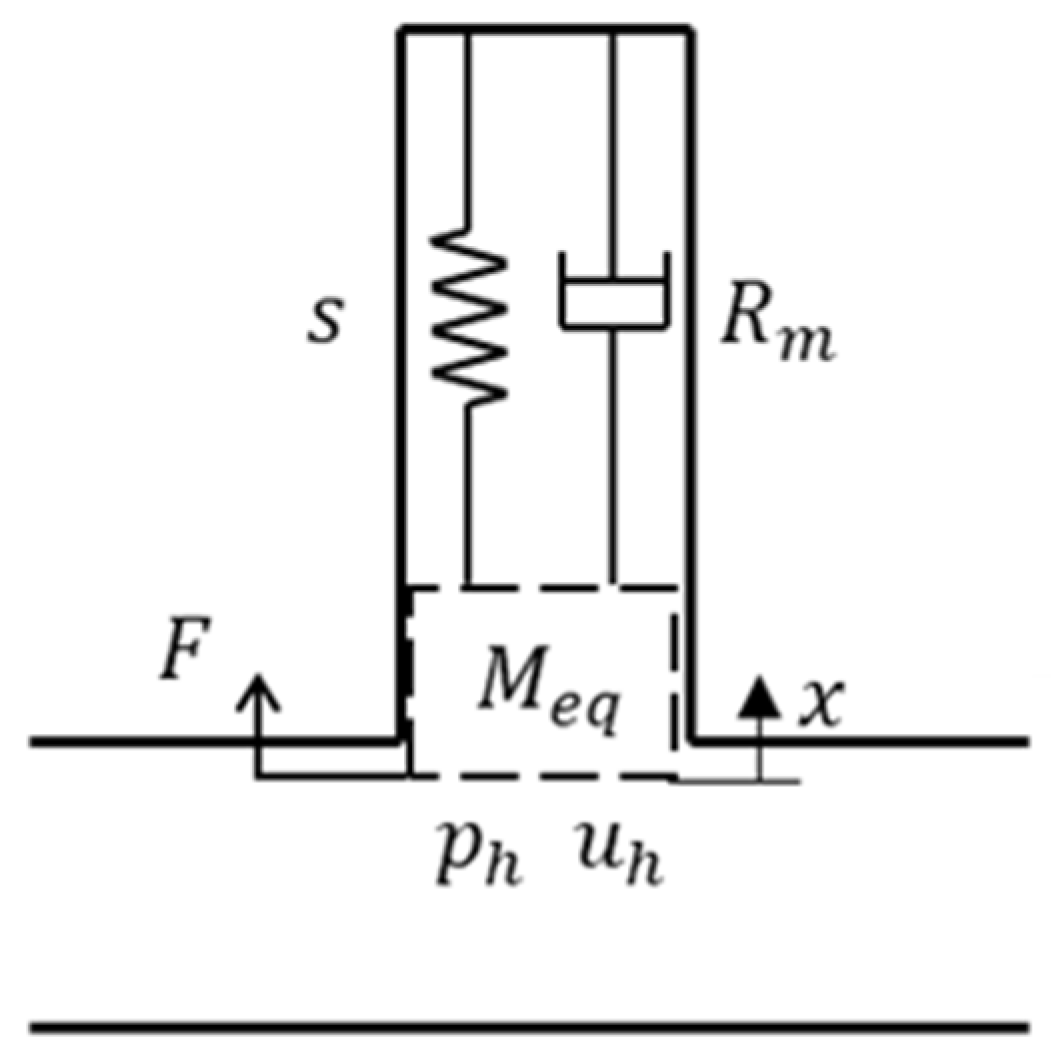

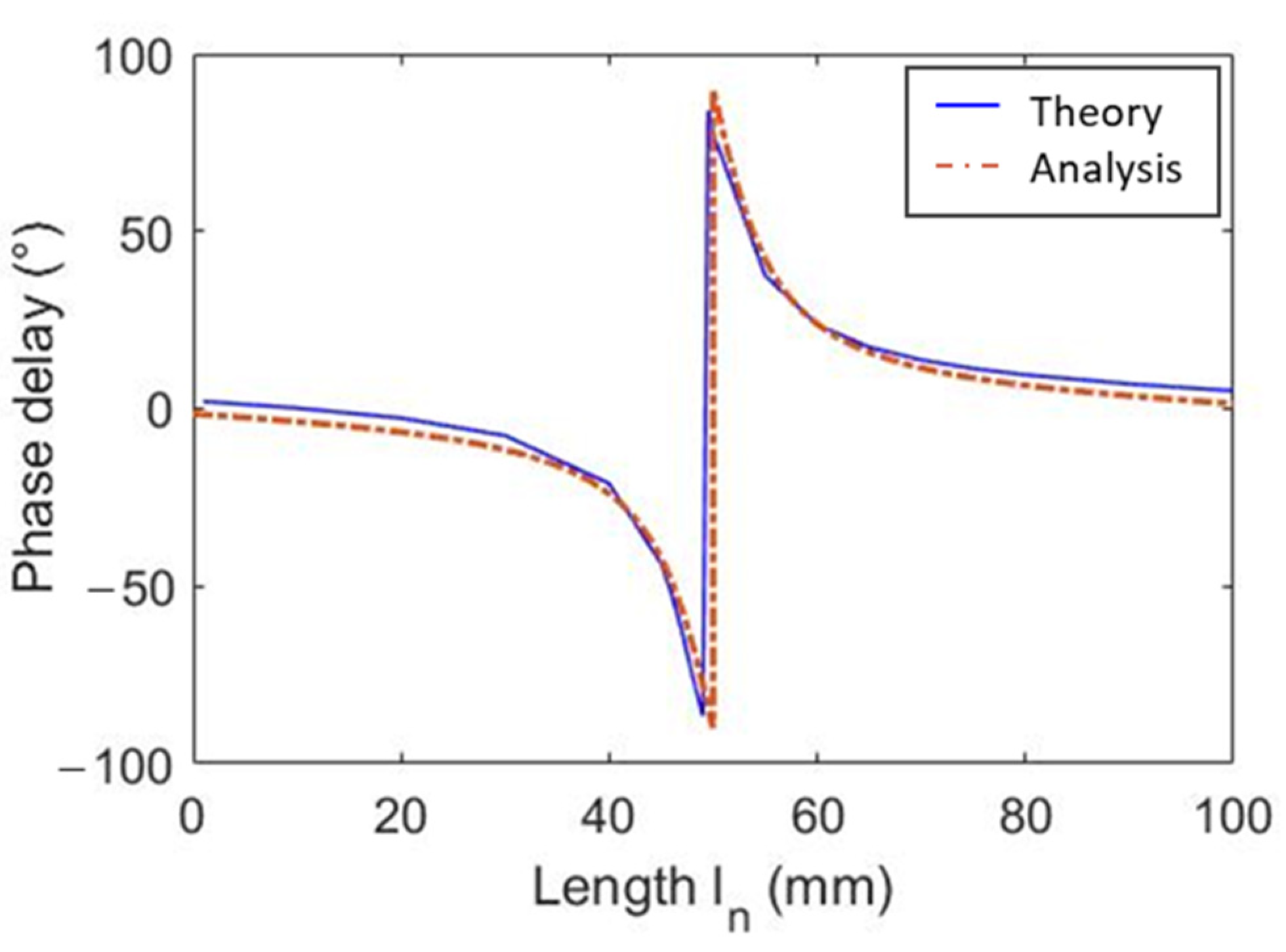
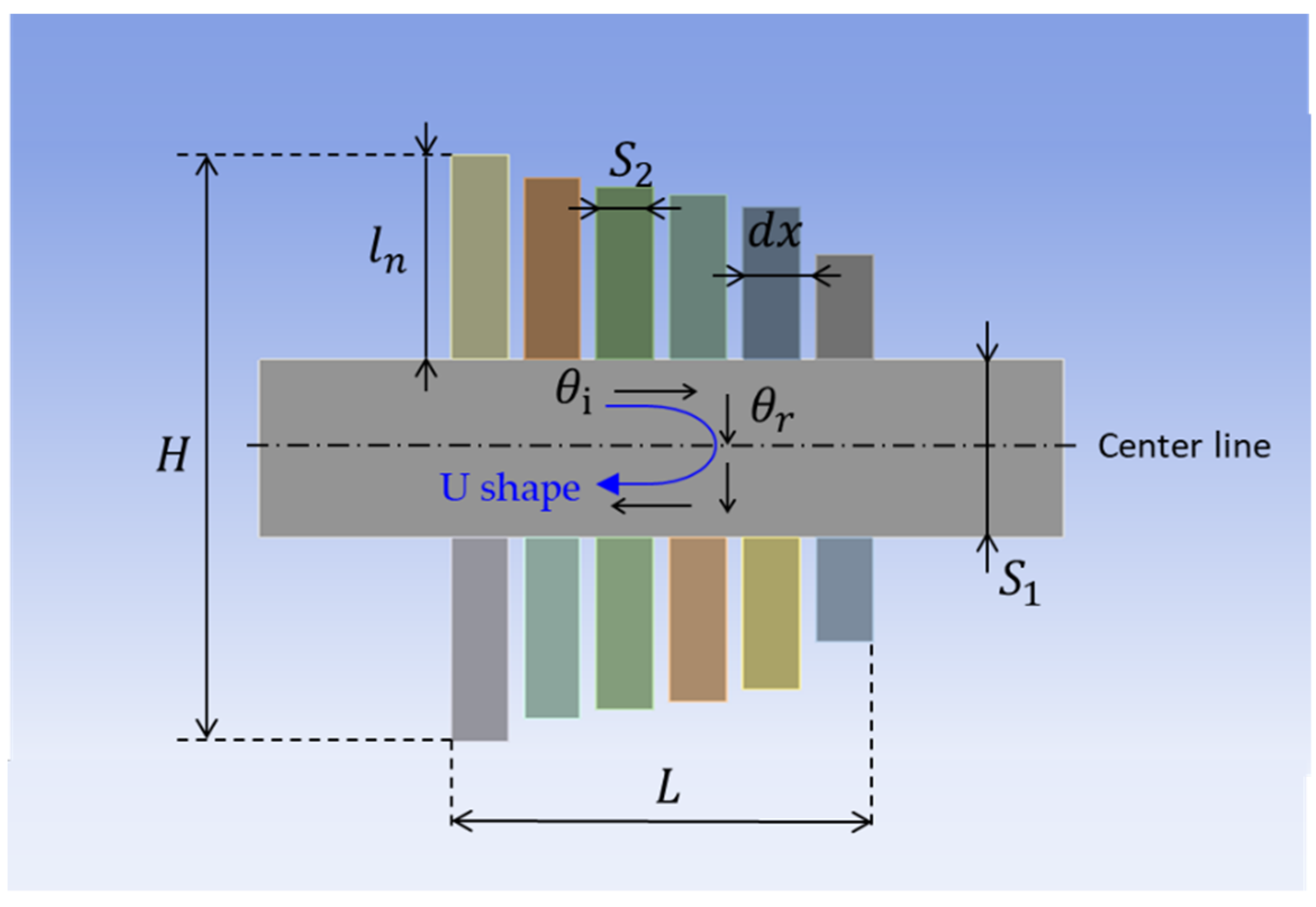

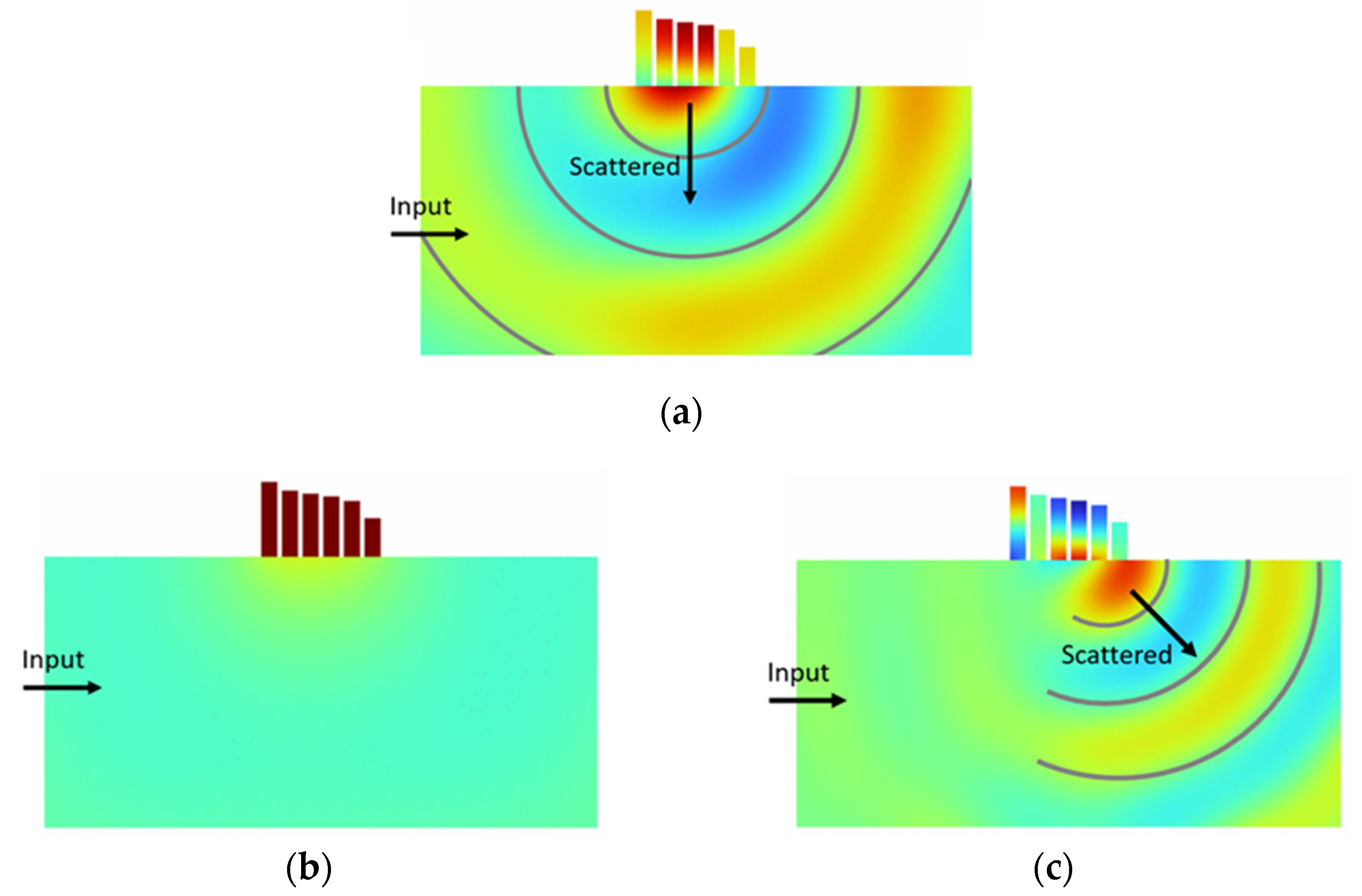
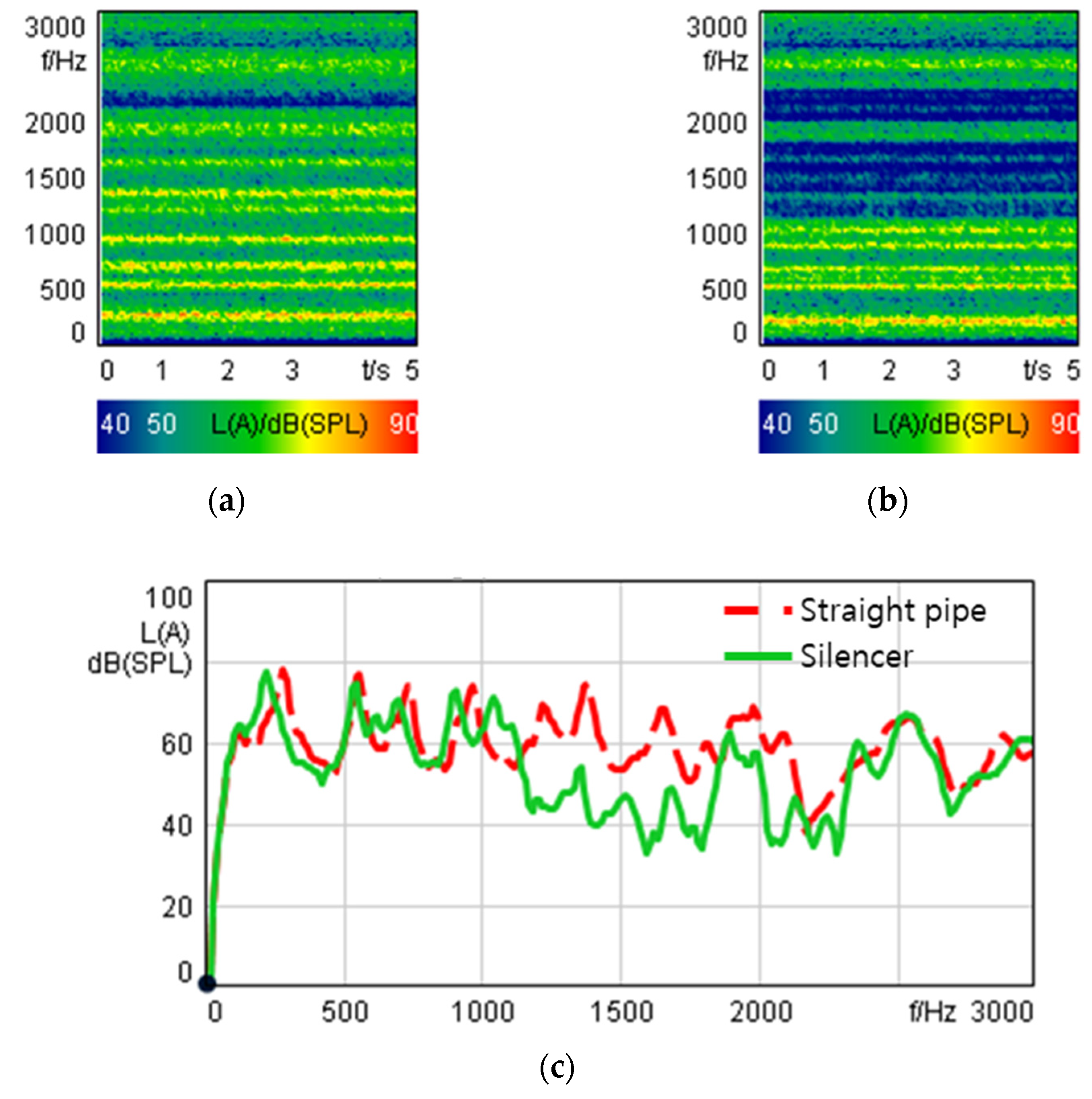

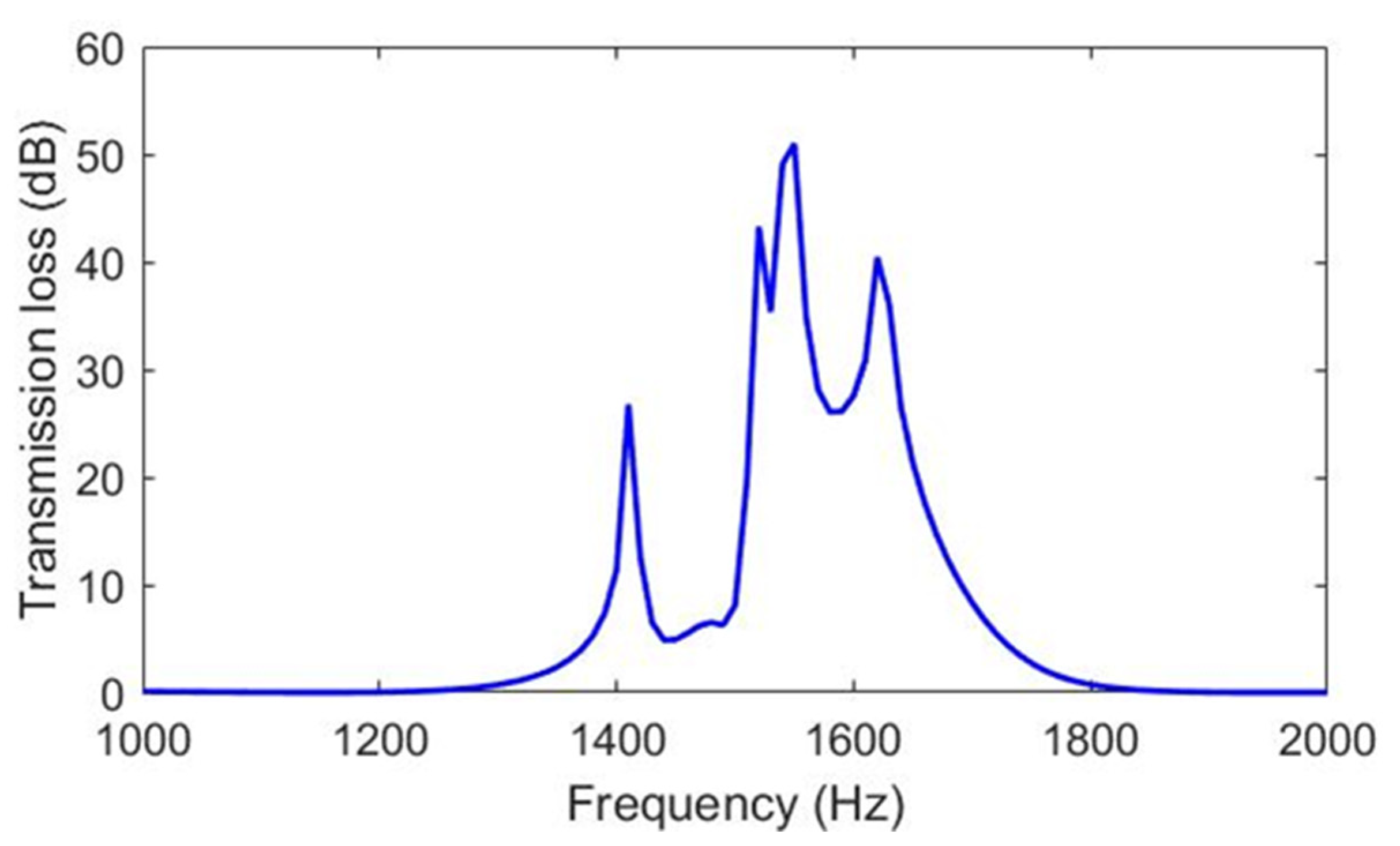


| upper part | 1500 Hz | 90° | 0° | 30° | 19.05 mm |
| lower part | 1500 Hz | 0° | 90° | 30° | 19.05 mm |
| 1500 Hz | 62.5 mm | 52.9 mm | 49.9 mm | 47.06 mm | 44.05 mm | 33.03 mm |
| 1500 Hz | 14.99 mm | 13.98 mm | 13.79 mm | 13.66 mm | 13.51 mm | 12.95 mm |
Disclaimer/Publisher’s Note: The statements, opinions and data contained in all publications are solely those of the individual author(s) and contributor(s) and not of MDPI and/or the editor(s). MDPI and/or the editor(s) disclaim responsibility for any injury to people or property resulting from any ideas, methods, instructions or products referred to in the content. |
© 2023 by the authors. Licensee MDPI, Basel, Switzerland. This article is an open access article distributed under the terms and conditions of the Creative Commons Attribution (CC BY) license (https://creativecommons.org/licenses/by/4.0/).
Share and Cite
Kim, H.; Kwon, Y.; Lee, S. Acoustic Metamaterial Design by Phase Delay Derivation Using Transfer Matrix. Symmetry 2023, 15, 689. https://doi.org/10.3390/sym15030689
Kim H, Kwon Y, Lee S. Acoustic Metamaterial Design by Phase Delay Derivation Using Transfer Matrix. Symmetry. 2023; 15(3):689. https://doi.org/10.3390/sym15030689
Chicago/Turabian StyleKim, Hyunsu, Yoonjung Kwon, and Sangwoo Lee. 2023. "Acoustic Metamaterial Design by Phase Delay Derivation Using Transfer Matrix" Symmetry 15, no. 3: 689. https://doi.org/10.3390/sym15030689
APA StyleKim, H., Kwon, Y., & Lee, S. (2023). Acoustic Metamaterial Design by Phase Delay Derivation Using Transfer Matrix. Symmetry, 15(3), 689. https://doi.org/10.3390/sym15030689





